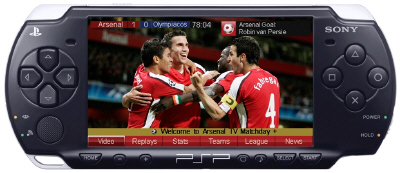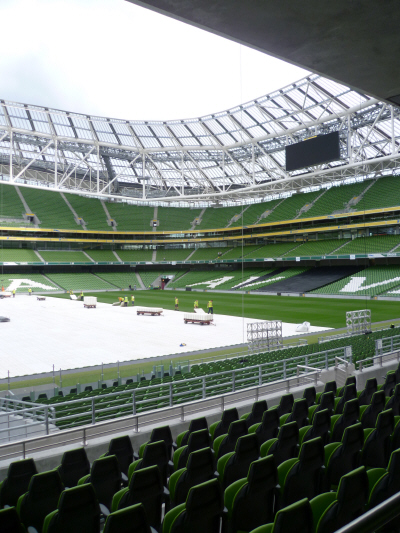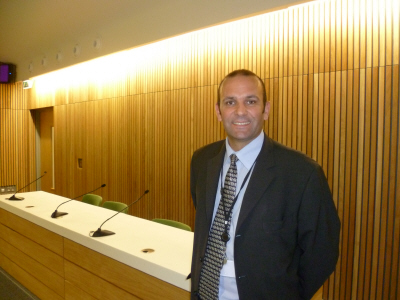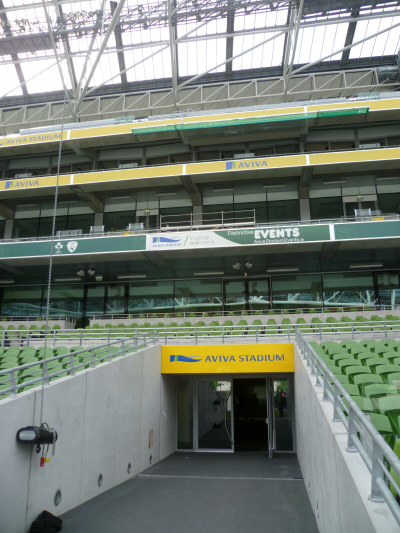In the business world, IT has been a key player for years, but in sports stadiums its role to date has been more like warming the substitutes’ bench. That’s changing: as clubs and sporting associations become more commercially focused and to meet development costs, they are increasingly bringing technology into the game to achieve their goals.
The new Aviva Stadium, on the site of the historic Lansdowne Road rugby and football ground, is a case in point. Needing to pay back its €410m price tag, the Aviva Stadium is not only a state-of-the-art sporting arena for the FAI and IRFU, but it has also been designed to be a conference centre, events space and entertainment venue (it has planning permission for three concerts per year).
“While we’re a football and rugby stadium, we’re a business, and we have to be sustainable. Anybody can throw 50,000 people around a rectangle of grass, but it’s about what you do around it,” explains Paul Charles, Aviva Stadium’s head of technical services. “We have around 20 matches on the pitch every year but you could be looking at potentially an event in every single space in the stand, every day and every night.”

Is this the future of matchday entertainment – streamed video to PSP
High performance
That helps to drive demand for top-performing technology that’s built into the stadium from the ground up, not just bolted on afterwards. “It’s one of the newest stadiums in the world, so you’re expecting the latest and greatest. You’ve got a certain perception to achieve,” adds Charles.
Siliconrepublic was granted extensive access to the Aviva recently, from the lush grass at pitchside to the plush carpet of the premium levels; the dressing rooms to the presidential suite; the three on-site TV studios and the control room at the stadium’s southeast corner where all the IT is managed.
If the scenery itself is impressive, so are the stats: 70km of cabling runs throughout the Aviva; it has 160 wireless access points and 4,000 data ports. There are 250 TVs around the stadium concourse, all HD-capable and set up to show the same images as those displayed on the large 90m sq screens visible from the stands. For conferences and events, up to five separate feeds can be used to display corporate videos and branding at different parts of the venue.
The broadband connection to the ground automatically bursts up to a 200Mbps symmetric line on match days, reverting to 20Mbps on other days. The stadium’s network can cope with up to 40 pitchside photographers sending large graphics files wirelessly from their laptops, not to mention a press tribune full of journalists filing copy.
There are 120 CCTVs in and around the stadium, 20 of which are mobile and can be deployed outside the ground for monitoring crowds as they arrive and leave.
The same infrastructure carrying all that traffic also carries feeds from the credit card payment terminals in the bars – some of which are wireless. As if that weren’t enough of a load, the network also carries the TV feed to outside broadcasters. According to Charles, separate broadcasters could even set up on either side of the ground and show the match simultaneously on two channels with different angles and adverts. Even the dressing rooms have a modern touch: video screens that managers can use to show footage from the match during the half-time team talk.

The view from the president’s box at Aviva Stadium
Planning
While it hasn’t been overtaken by technological advances, the planning process for the Aviva Stadium began so long ago that Wi-Fi access wasn’t originally included. Some late adjustments to the teamsheet meant it was added to the starting design, while other technologies were dropped. “Five years ago on the original spec I even saw a dot matrix printer,” jokes Charles.
The stadium has also coped with heavy IT requests for some conferences, combining wireless and wired internet access, as well as the ability to change access passwords on a daily basis.
Interestingly, all of the IT hardware is located on site, all managed by just one person: the stadium’s IT and automation engineer Ronan Burke. Managed services are well established and cloud computing may be all the rage, but Charles doesn’t see it that way. “If something is worth doing, it’s worth doing yourself,” he says. “These things are our bread and butter on a match day, and you want to keep them close.”
It makes no sense to employ a large IT team because the nature of the venue is that they could be idle much of the time. Charles notes as an aside that Wembley reportedly had an IT staff of 50 at one point, although it has since scaled back.

Aviva Stadium’s head of technical services Paul Charles at the stadium’s press room
Emirates example
Arsenal’s Emirates Stadium is widely considered as a best practice model for modern football grounds. Aviva Stadium’s Charles openly acknowledges the debt it owes to its London counterpart, saying, “If we just copy what they do, we could do a lot worse.”
Sony Professional is the technology provider for Arsenal’s stadium since it relocated from Highbury in 2006. Jonathan White, Sony Professional’s UK and Ireland business-to-business director, explains this change: “Before, a fan would arrive, watch the sports event and leave. The trend now is around increasing fans’ interaction with their sporting team or club and increasing the time spent around the stadium,” he says.
Charles agrees with this sentiment. “As a stadium, perhaps you can entice the supporters to have the last pint here, instead of being in the pub and getting another round in before kickoff,” he says.
Whether stadia have been built from the ground up or extensively redeveloped, technology is no longer the poor relation and it’s finally being allocated a budget that reflects its value. “The technology spend has not been a case of ‘what money have we got left’, it’s been, how can we use the likes of digital signage to help the club sell more merchandise, drinks or food, or to get fans into the ground earlier. There’s a far deeper understanding of what technology can offer clubs,” says White.
Single network
Previously, screens in the ground were standalone systems. Now that’s changing, and just as in business, this has all converged on a single internet protocol network. “Good stadium managers are treating the network the way a network manager would in an enterprise,” comments White.
Digital content can be pushed to all screens or specific content can be transmitted to the concourse where fans are gathering before the match. Many clubs now have their own TV stations, and the same player interviews or match highlights that are on the clubs’ websites can also be shown around the ground before kickoff.
A trend from North America, not yet seen on this side of the Atlantic, is to change the content that’s shown on certain screens and tailor it for particular areas within the ground. “On an IP network in a stadium you can do that,” says White.
The same network also handles video feeds from the CCTV cameras. Intelligence built into these systems now means they go beyond just stadium security – for example, they can let stadium managers know if fans at certain kiosks are queueing too long for food.

The players’ tunnel at Aviva Stadium
High definition
Just as in the home TV market, high definition is the technology of choice for best practice stadia, White claims. 3D is at a very early stage but some applications are starting to emerge, such as fixing three cameras in a way that captures the entire length of the pitch, from goalmouth to goalmouth, and displays it on a single screen. White says the footage could then be shown in concourse areas and would allow “immersive replays” of events during the match that a fan behind the goal might not have been able to see clearly. The software was demo’d recently at the IBC show and is due to be commercially available before the end of the year.
Stadium operators are also likely to use the growing number of consumer mobile devices as another way of reaching out to supporters. Arsenal has already tested sending video streams of a live match to PSP devices, allowing fans in the Emirates to look at replays of goals and incidents from different camera angles.
Bandwidth issues can mean there is a natural delay in sending the signal to mobile devices, but that’s not necessarily a disadvantage, claims White. “Fans like the delay because they want to see the game live. They don’t want to look up occasionally at the match.” In theory, the same kind of service could be provided to a wider range of mobile handsets, he adds. “It’s not restricted to that (PSP) platform, and obviously smartphones are a massive growth trend.”
Sport is big business, and stadiums are having to do much more than just put bums on seats – they are multi-purpose entertainment venues and an essential part of any club or association looking to increase revenues. Not so long ago, it was enough for the sports fan to boast “I was there.” Now thanks to technology, that’s just the beginning.